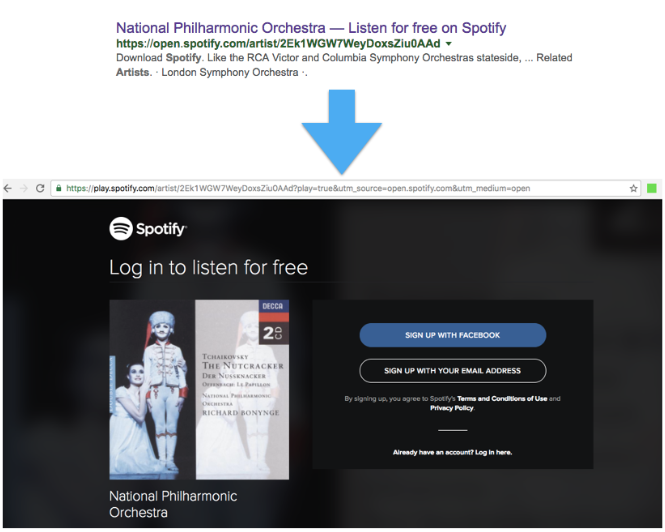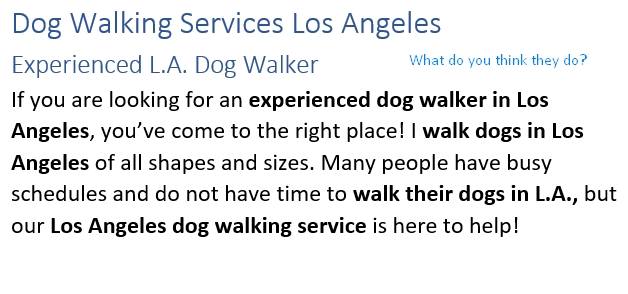While you don’t need to know about this tag just yet, the main thing to note for now is that your content should be unique in word and in value. When you link to other pages on your website, you ensure that search engine crawlers can find all your site’s pages, you pass link equity (ranking power) to other pages on your site, and you help visitors navigate your site. For example, if I link to a page on my site using the anchor text “learn SEO,” that’s a good indicator to search engines that the targeted page is one at which people can learn about SEO. Example of a redirect chain: (original location of content) example.com/location1 >> example.com/location2 >> (current location of content) example.com/location3 Better: example.com/location1 >> example.com/location3 Image optimization Images are the biggest culprits of slow web pages! Search engine bots also crawl alt text to better understand your images, which gives you the added benefit of providing better image context to search engines. Keyword usage: Having your target keyword in the title can help both users and search engines understand what your page is about. They are also nested in the head tag, and look like this:
What you input into the description field will show up here in search results: In many cases though, Google will choose different snippets of text to display in search results, dependent upon the searcher’s query. Like title tags and meta descriptions, search engines display URLs on the SERPs, so URL naming and format can impact click-through rates. Not only do searchers use them to make decisions about which web pages to click on, but URLs are also used by search engines in evaluating and ranking pages. Search engines require unique URLs for each page on your website so they can display your pages in search results, but clear URL structure and naming is also helpful for people who are trying to understand what a specific URL is about.
Chapter Four of the Beginner’s Guide to SEO rewrite is chock full of on-page SEO learnings. After all the great feedback you’ve provided thus far on our outline, Chapter One, Chapter Two, and Chapter Three, we’re eager to hear how you feel about Chapter Four. What really works for you? What do you think is missing? Read on, and let us know your thoughts in the comments!
Chapter 4: On-Page Optimization
Use your research to craft your message.
Now that you know how your target market is searching, it’s time to dive into on-page optimization, the practice of crafting web pages that answer searcher’s questions. On-page SEO is multifaceted, and extends beyond content into other things like schema and meta tags, which we’ll discuss more at length in the next chapter on technical optimization. For now, put on your wordsmithing hats — it’s time to create your content!
Creating your content
Applying your keyword research
In the last chapter, we learned methods for discovering how your target audience is searching for your content. Now, it’s time to put that research into practice. Here is a simple outline to follow for applying your keyword research:
- Survey your keywords and group those with similar topics and intent. Those groups will be your pages, rather than creating individual pages for every keyword variation.
- If you haven’t done so already, evaluate the SERP for each keyword or group of keywords to determine what type and format your content should be. Some characteristics of ranking pages to take note of:
- Are they image or video heavy?
- Is the content long-form or short and concise?
- Is the content formatted in lists, bullets, or paragraphs?
- Ask yourself, “What unique value could I offer to make my page better than the pages that are currently ranking for my keyword?”
On-page optimization allows you to turn your research into content your audience will love. Just make sure to avoid falling into the trap of low-value tactics that could hurt more than help!
Low-value tactics to avoid
Your web content should exist to answer searchers’ questions, to guide them through your site, and to help them understand your site’s purpose. Content should not be created for the purpose of ranking highly in search alone. Ranking is a means to an end, the end being to help searchers. If we put the cart before the horse, we risk falling into the trap of low-value content tactics.
Some of these tactics were introduced in Chapter 2, but by way of review, let’s take a deeper dive into some low-value tactics you should avoid when crafting search engine optimized content.
While it’s common for a website to have unique pages on different topics, an older content strategy was to create a page for every single iteration of your keywords in order to rank on page 1 for those highly specific queries.
For example, if you were selling bridal dresses, you might have created individual pages for bridal gowns, bridal dresses, wedding gowns, and wedding dresses, even if each page was essentially saying the same thing. A similar tactic for local businesses was to create multiple pages of content for each city or region from which they wanted clients. These “geo pages” often had the same or very similar content, with the location name being the only unique factor.
Tactics like these clearly weren’t helpful for users, so why did publishers do it? Google wasn’t always as good as it is today at understanding the relationships between words and phrases (or semantics). So, if you wanted to rank on page 1 for “bridal gowns” but you only had a page on “wedding dresses,” that may not have cut it.
This practice created tons of thin, low-quality content across the web, which Google addressed specifically with its 2011 update known as Panda. This algorithm update penalized low-quality pages, which resulted in more quality pages taking the top spots of the SERPs. Google continues to iterate on this process of demoting low-quality content and promoting high-quality content today.
Google is clear that you should have a comprehensive page on a topic instead of multiple, weaker pages for each variation of a keyword.

Like it sounds, “duplicate content” refers to content that is shared between domains or between multiple pages of a single domain. “Scraped” content goes a step further, and entails the blatant and unauthorized use of content from other sites. This can include taking content and republishing as-is, or modifying it slightly before republishing, without adding any original content or value.
There are plenty of legitimate reasons for internal or cross-domain duplicate content, so Google encourages the use of a rel=canonical tag to point to the original version of the web content. While you don’t need to know about this tag just yet, the main thing to note for now is that your content should be unique in word and in value.

A basic tenet of search engine guidelines is to show the same content to the engine’s crawlers that you’d show to a human visitor. This means that you should never hide text in the HTML code of your website that a normal visitor can’t see.
When this guideline is broken, search engines call it “cloaking” and take action to prevent these pages from ranking in search results. Cloaking can be accomplished in any number of ways and for a variety of reasons, both positive and negative. Below is an example of an instance where Spotify showed different content to users than to Google.


In some cases, Google may let practices that are technically cloaking pass because they contribute to a positive user experience. For more on the subject of cloaking and the levels of risk associated with various tactics, see our article on White Hat Cloaking.
Keyword stuffing
If you’ve ever been told, “You need to include {critical keyword} on this page X times,” you’ve seen the confusion over keyword usage in action. Many people mistakenly think that if you just include a keyword within your page’s content X times, you will automatically rank for it. The truth is, although Google looks for mentions of keywords and related concepts on your site’s pages, the page itself has to add value outside of pure keyword usage. If a page is going to be valuable to users, it won’t sound like it was written by a robot, so incorporate your keywords and phrases naturally in a way that is understandable to your readers.
Below is an example of a keyword-stuffed page of content that also uses another old method: bolding all your targeted keywords. Oy.

Arguably one of the most offensive forms of low quality content is the kind that is auto-generated, or created programmatically with the intent of manipulating search rankings and not helping users. You may recognize some auto-generated content by how little it makes sense when read — they are technically words, but strung together by a program rather than a human being.

It is worth noting that advancements in machine learning have contributed to more sophisticated auto-generated content that will only get better over time. This is likely why in Google’s quality guidelines on automatically generated content, Google specifically calls out the brand of auto-generated content that attempts to manipulate search rankings, rather than any-and-all auto-generated content.
What to do instead: 10x it!
There is no “secret sauce” to ranking in search results. Google ranks pages highly because it has determined they are the best answers to the searcher’s questions. In today’s search engine, it’s not enough that your page isn’t duplicate, spamming, or broken. Your page has to provide value to searchers and be better than any other page Google is currently serving as the answer to a particular query. Here’s a simple formula for content creation:
- Search the keyword(s) you want your page to rank for
- Identify which pages are ranking highly for those keywords
- Determine what qualities those pages possess
- Create content that’s better than that
We like to call this 10x content. If you create a page on a keyword that is 10x better than the pages being shown in search results (for that keyword), Google will reward you for it, and better yet, you’ll naturally get people linking to it! Creating 10x content is hard work, but will pay dividends in organic traffic.
Just remember, there’s no magic number when it comes to words on a page. What we should be aiming for is whatever sufficiently satisfies user intent. Some queries can be answered thoroughly and accurately in 300 words while others might require 1,000 words!
Pro tip: Don’t reinvent the wheel!
If you already have content on your website, save yourself time by evaluating which of those pages are already bringing in good amounts of organic traffic and converting well. Refurbish that content on different platforms to help get more visibility to your site. On the other side of the coin, evaluate what existing content isn’t performing as well and adjust it, rather than starting from square one with all new content.
NAP: A note for local businesses
If you’re a business that makes in-person contact with your customers, be sure to include your business name, address, and phone number (NAP) prominently, accurately, and consistently throughout your site’s content. This information is often displayed in the footer or header of a local business website, as well as on any “contact us” pages. You’ll also want to mark up this information using local business schema. Schema and structured data are discussed more at length in the “Code” section of this chapter.
If you are a multi-location business, it’s best to build unique, optimized pages for each location. For example, a business that has locations in Seattle, Tacoma, and Bellevue should consider having a page for each:
example.com/seattle example.com/tacoma example.com/bellevue
Each page should be uniquely optimized for that location, so the Seattle page would have unique content discussing the Seattle location, list the Seattle NAP, and even testimonials specifically from Seattle customers. If there are dozens, hundreds, or even thousands of locations, a store locator widget could be employed to help you scale.
Hope you still have some energy left after handling the difficult-yet-rewarding task of putting together a page that is 10x better than your competitors’ pages, because there are just a few more things needed before your page is complete! In the next sections, we’ll talk about the other on-page optimizations your pages need, as well as naming and organizing your content.
Beyond content: Other optimizations your pages need
Can I just bump up the font size to create paragraph headings?
How can I control what title and description show up for my page in search results?
After reading this section, you’ll understand other important on-page elements that help search engines understand the 10x content you just created, so let’s dive in!
Header tags
Header tags are an HTML element used to designate headings on your page. The main header tag, called an H1, is typically reserved for the title of the page. It looks like this:
<h1>Page Title</h1>
There are also sub-headings that go from H2 (<h2>) to H6 (<h6>) tags, although using all of these on a page is not required. The hierarchy of header tags goes from H1 to H6 in descending order of importance.
Each page should have a unique H1 that describes the main topic of the page, this is often automatically created from the title of a page. As the main descriptive title of the page, the H1 should contain that page’s primary keyword or phrase. You should avoid using header tags to mark up non-heading elements, such as navigational buttons and phone numbers. Use header tags to introduce what the following content will discuss.
Take this page about touring Copenhagen, for example:
<h1>Copenhagen Travel Guide</h1> <h2>Copenhagen by the Seasons</h2> <h3>Visiting in Winter</h3> <h3>Visiting in Spring</h3>
The main topic of the page is introduced in the main <h1> heading, and each additional heading is used to introduce a new sub-topic. In this example, the <h2> is more specific than the <h1>, and the <h3> tags are more specific than the <h2>. This is just an example of a structure you could use.
Although what…

COMMENTS